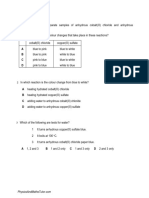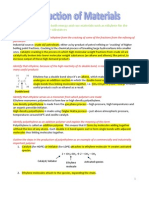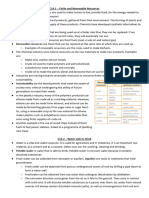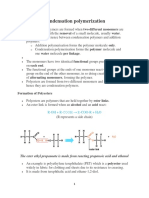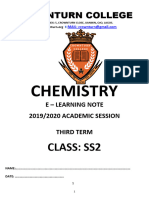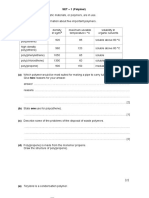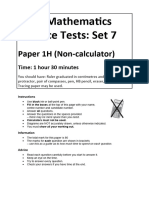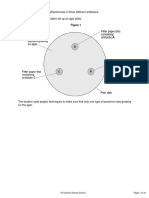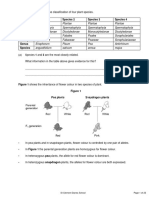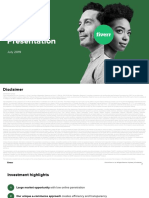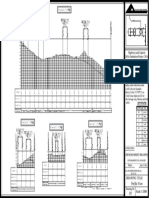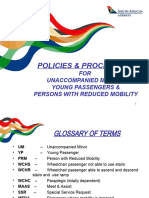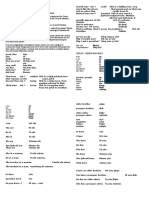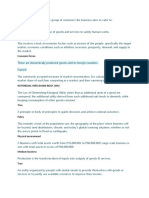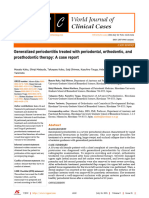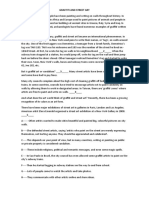Using Resources QP
Uploaded by
lizablatchfordUsing Resources QP
Uploaded by
lizablatchfordThis question is about water.
1.
(a) Sewage is waste water.
Sewage contains organic matter.
Describe how sewage is treated to remove organic matter.
___________________________________________________________________
___________________________________________________________________
___________________________________________________________________
___________________________________________________________________
___________________________________________________________________
___________________________________________________________________
___________________________________________________________________
___________________________________________________________________
(4)
Sea water and ground water are treated to make them potable.
The table below shows information about the composition and treatment of sea water and of
ground water.
Sea water Ground water
Concentration of sodium ions and Na+ : 0.5 mol/dm3 Na+ : 0.001 mol/dm3
chloride ions before Process 1 Cl− : 0.5 mol/dm3 Cl− : 0.001 mol/dm3
Process 1 Reverse osmosis Filtration
Concentration of sodium ions and Na+ : 0.001 mol/dm3
X
chloride ions after Process 1 Cl− : 0.001 mol/dm3
Process 2 Add ozone Expose to ultraviolet light
St Clement Danes School Page 1 of 22
(b) Sea water is desalinated during Process 1.
Which pair of concentrations could represent X in the table above?
✓) one box.
Tick (✓
Na+ : 0.003 mol/dm3 Cl− : 0.003 mol/dm3
Na+ : 0.003 mol/dm3 Cl− : 0.5 mol/dm3
Na+ : 0.5 mol/dm3 Cl− : 0.003 mol/dm3
Na+ : 0.5 mol/dm3 Cl− : 0.5 mol/dm3
(1)
(c) Explain why the concentrations of sodium ions and of chloride ions in the ground water in
the table above are unchanged by Process 1.
___________________________________________________________________
___________________________________________________________________
___________________________________________________________________
___________________________________________________________________
(2)
(d) Explain why the ground water in the table above requires Process 2 before the water is
safe to drink.
___________________________________________________________________
___________________________________________________________________
___________________________________________________________________
___________________________________________________________________
(2)
St Clement Danes School Page 2 of 22
(e) After treatment the ground water in the table above is sold by a company as pure water.
The ground water in above table is not chemically pure because the water contains sodium
ions and chloride ions.
Suggest what the company means by ‘pure’.
___________________________________________________________________
___________________________________________________________________
(1)
(f) Chlorine is also used to treat some ground water.
Describe the test for chlorine gas.
Give the result of the test.
Test ______________________________________________________________
___________________________________________________________________
Result _____________________________________________________________
___________________________________________________________________
(2)
(Total 12 marks)
St Clement Danes School Page 3 of 22
Good quality water is needed for a healthy life.
2.
In the United Kingdom, obtaining safe water for drinking is as simple as turning on a tap.
The water is made safe to drink by water companies.
However, in many parts of Africa and Asia, water used for drinking is contaminated and
untreated. It is estimated that 2.2 million people die each year as a result of drinking
contaminated water.
DADA DANESHANANDA, Man with filtered water from the
Mafi-Zongo water project. www.amurt.net/africa/ghana/2005
Efforts are being made to solve this problem and more water is being treated.
Describe how water in the United Kingdom is treated.
Explain how this makes it safe to drink.
_______________________________________________________________________
_______________________________________________________________________
_______________________________________________________________________
_______________________________________________________________________
_______________________________________________________________________
_______________________________________________________________________
_______________________________________________________________________
_______________________________________________________________________
(Total 3 marks)
St Clement Danes School Page 4 of 22
This question is about polymers.
3.
(a) Polyesters are produced when monomers join together and lose a small molecule.
Name the small molecule lost.
___________________________________________________________________
(1)
(b) Poly(propene) is produced from propene.
Complete the structure of poly(propene) in the equation.
(3)
(c) Carpets are made from:
• poly(propene)
• wool
• a mixture of poly(propene) and wool.
Poly(propene) wears out more slowly than wool.
A mixture of poly(propene) and wool to make carpets is more sustainable than using just
poly(propene) or just wool.
Suggest why.
___________________________________________________________________
___________________________________________________________________
___________________________________________________________________
___________________________________________________________________
(2)
St Clement Danes School Page 5 of 22
Polymer fibres are used to make firefighter uniforms.
The table below shows some properties of two polymer fibres.
Polymer fibres
Property Poly(propene) Polyester
Density in g/cm3 0.90 1.38
Melting point in °C 165 260
Flame resistance Poor Good
Water absorption Low High
(d) Evaluate the suitability of poly(propene) and polyester for firefighter uniforms.
___________________________________________________________________
___________________________________________________________________
___________________________________________________________________
___________________________________________________________________
___________________________________________________________________
___________________________________________________________________
___________________________________________________________________
___________________________________________________________________
___________________________________________________________________
___________________________________________________________________
(4)
(Total 10 marks)
St Clement Danes School Page 6 of 22
This question is about copper and alloys of copper.
4.
Solders are alloys used to join metals together.
Some solders contain copper.
The table below shows information about three solders, A, B and C.
Solder Melting point in °C Metals in solder
A 183 tin, copper, lead
B 228 tin, copper, silver
C 217 tin, copper, silver
(a) Solder B and solder C are now used more frequently than solder A for health reasons.
Suggest one reason why.
Use the table above.
___________________________________________________________________
___________________________________________________________________
(1)
(b) Suggest one reason why solders B and C have different melting points.
Use the table above.
___________________________________________________________________
___________________________________________________________________
(1)
Copper can be obtained by:
• processing copper ores
• recycling scrap copper.
St Clement Danes School Page 7 of 22
(c) Suggest three reasons why recycling scrap copper is a more sustainable way of obtaining
copper than processing copper ores.
1 _________________________________________________________________
___________________________________________________________________
2 _________________________________________________________________
___________________________________________________________________
3 _________________________________________________________________
___________________________________________________________________
(3)
Copper is extracted from low-grade ores by phytomining.
(d) Describe how copper is extracted from low-grade ores by phytomining.
___________________________________________________________________
___________________________________________________________________
___________________________________________________________________
___________________________________________________________________
___________________________________________________________________
___________________________________________________________________
___________________________________________________________________
___________________________________________________________________
(4)
(e) Phytomining has not been widely used to extract copper.
Suggest two reasons why.
1 _________________________________________________________________
___________________________________________________________________
2 _________________________________________________________________
___________________________________________________________________
(2)
(Total 11 marks)
St Clement Danes School Page 8 of 22
This question is about materials used to make food plates.
5.
Food plates are made from paper, polymers or ceramics.
The table below shows information about plates of the same diameter made from each of these
materials.
Food plate material
Paper Polymers Ceramics
Raw material Wood Crude oil Mined clay
Number packaged in 10 dm3
500 100 50
cardboard box
Average number of times
1 400 1000
used
Biodegradable? Yes No No
Recyclable? Yes Yes No
(a) The table above does not show information about energy usage.
Suggest two pieces of information about energy usage which would help to produce a
complete life cycle assessment (LCA) for the three food plate materials.
1 _________________________________________________________________
___________________________________________________________________
2 _________________________________________________________________
___________________________________________________________________
(2)
St Clement Danes School Page 9 of 22
(b) Evaluate the use of these materials for making food plates.
You should use features of life cycle assessments (LCAs).
Use the table above.
___________________________________________________________________
___________________________________________________________________
___________________________________________________________________
___________________________________________________________________
___________________________________________________________________
___________________________________________________________________
___________________________________________________________________
___________________________________________________________________
___________________________________________________________________
___________________________________________________________________
___________________________________________________________________
___________________________________________________________________
(4)
(c) Describe how ceramic food plates are produced from clay.
___________________________________________________________________
___________________________________________________________________
___________________________________________________________________
___________________________________________________________________
(2)
(Total 8 marks)
St Clement Danes School Page 10 of 22
A large amount of aluminium sulfate was accidentally added to the drinking water supply at a
6. water treatment works.
(a) Describe a test to show that the drinking water contained aluminium ions.
Give the result of the test.
Test _______________________________________________________________
___________________________________________________________________
Result _____________________________________________________________
___________________________________________________________________
___________________________________________________________________
___________________________________________________________________
(3)
(b) Describe a test to show that the drinking water contained sulfate ions.
Give the result of the test.
Test _______________________________________________________________
___________________________________________________________________
Result _____________________________________________________________
___________________________________________________________________
(2)
St Clement Danes School Page 11 of 22
(c) Plan an investigation to find the total mass of dissolved solids in a 100 cm3 sample of the
drinking water.
Your investigation should produce valid results.
___________________________________________________________________
___________________________________________________________________
___________________________________________________________________
___________________________________________________________________
___________________________________________________________________
___________________________________________________________________
___________________________________________________________________
___________________________________________________________________
___________________________________________________________________
___________________________________________________________________
___________________________________________________________________
___________________________________________________________________
(4)
(Total 9 marks)
This question is about combustion of fuels.
7.
(a) Some central heating boilers use wood as a fuel.
Suggest two reasons why wood is more sustainable than natural gas as a fuel for central
heating boilers.
1 _________________________________________________________________
___________________________________________________________________
2 _________________________________________________________________
___________________________________________________________________
(2)
St Clement Danes School Page 12 of 22
Natural gas is mainly methane.
When methane burns it can produce both carbon monoxide and carbon dioxide.
(b) Explain the process by which carbon monoxide can be produced when methane is burned.
___________________________________________________________________
___________________________________________________________________
___________________________________________________________________
___________________________________________________________________
(2)
(c) Balance the equation for the combustion of methane to produce carbon monoxide.
____CH4(g) + ____ O2(g) → ____ CO(g) + ____ H2O(l)
(1)
(d) Propane burns to form carbon dioxide and water.
The equation for the reaction is:
C3H8(g) + 5 O2(g) → 3 CO2(g) + 4 H2O(l)
3.60 dm3 carbon dioxide is produced when a sample of propane is burned in 7.25 dm3
oxygen.
Calculate the volume of unreacted oxygen.
Give your answer in cm3
___________________________________________________________________
___________________________________________________________________
___________________________________________________________________
___________________________________________________________________
___________________________________________________________________
___________________________________________________________________
___________________________________________________________________
___________________________________________________________________
Volume of unreacted oxygen = __________________________ cm3
(4)
(Total 9 marks)
St Clement Danes School Page 13 of 22
This question is about copper.
8.
(a) Copper can be extracted by smelting copper-rich ores in a furnace.
The equation for one of the reactions in the smelting process is:
Cu2S(s) + O2(g) 2 Cu(s) + SO2(g)
Explain why there would be an environmental problem if sulfur dioxide gas escaped into
the atmosphere.
___________________________________________________________________
___________________________________________________________________
___________________________________________________________________
___________________________________________________________________
(2)
(b) The impure copper produced by smelting is purified by electrolysis, as shown below.
Copper atoms are oxidised at the positive electrode to Cu2+ ions, as shown in the half
equation.
Cu(s) Cu2+(aq) + 2e−
(i) How does the half equation show that copper atoms are oxidised?
______________________________________________________________
______________________________________________________________
(1)
St Clement Danes School Page 14 of 22
(ii) The Cu2+ ions are attracted to the negative electrode, where they are reduced to
produce copper atoms.
Write a balanced half equation for the reaction at the negative electrode.
______________________________________________________________
(1)
(iii) Suggest a suitable electrolyte for the electrolysis.
______________________________________________________________
(1)
(c) Copper metal is used in electrical appliances.
Describe the bonding in a metal, and explain why metals conduct electricity.
___________________________________________________________________
___________________________________________________________________
___________________________________________________________________
___________________________________________________________________
___________________________________________________________________
___________________________________________________________________
___________________________________________________________________
___________________________________________________________________
___________________________________________________________________
(4)
(d) Soil near copper mines is often contaminated with low percentages of copper compounds.
Phytomining is a new way to extract copper compounds from soil.
Describe how copper compounds are extracted by phytomining.
___________________________________________________________________
___________________________________________________________________
___________________________________________________________________
___________________________________________________________________
___________________________________________________________________
___________________________________________________________________
(3)
St Clement Danes School Page 15 of 22
(e) A compound in a copper ore has the following percentage composition by mass:
55.6% copper, 16.4% iron, 28.0% sulfur.
Calculate the empirical formula of the compound.
Relative atomic masses (Ar): S = 32; Fe = 56; Cu = 63.5
You must show all of your working.
___________________________________________________________________
___________________________________________________________________
___________________________________________________________________
___________________________________________________________________
___________________________________________________________________
___________________________________________________________________
___________________________________________________________________
___________________________________________________________________
Empirical formula = ______________________________
(4)
(Total 16 marks)
St Clement Danes School Page 16 of 22
This question is about copper.
9.
(a) Most of the copper extracted is used in electric circuits.
The figure below shows how impurities change the electrical conductivity of copper.
Percentage of impurities in copper
Copper extracted by smelting is about 99% pure.
The 99% pure copper produced by smelting is purified to 99.9999% pure copper by
electrolysis.
Use values from the graph to explain why copper is purified to 99.9999%.
___________________________________________________________________
___________________________________________________________________
___________________________________________________________________
___________________________________________________________________
(2)
St Clement Danes School Page 17 of 22
(b) In this question you will be assessed on using good English, organising information
clearly and using specialist terms where appropriate.
Read the information in the box.
Copper extraction
World demand for copper for the year 2011 was about 20 million tonnes.
World reserves of copper are estimated to be 700 million tonnes.
Most of the copper used is obtained from copper ores, which are mined.
The copper ore chalcopyrite is heated in a furnace to produce copper sulfide, CuS
The furnace is heated by burning fossil fuels.
Air is then blown through the hot copper sulfide, to produce copper and sulfur dioxide.
CuS + O2 → Cu + SO2
St Clement Danes School Page 18 of 22
A scientist made the statement: ‘Copper should be recycled’.
Use the information in the box and your own knowledge and understanding to justify the
scientist’s statement.
___________________________________________________________________
___________________________________________________________________
___________________________________________________________________
___________________________________________________________________
___________________________________________________________________
___________________________________________________________________
___________________________________________________________________
___________________________________________________________________
___________________________________________________________________
___________________________________________________________________
___________________________________________________________________
___________________________________________________________________
___________________________________________________________________
___________________________________________________________________
___________________________________________________________________
___________________________________________________________________
Extra space _________________________________________________________
___________________________________________________________________
___________________________________________________________________
___________________________________________________________________
___________________________________________________________________
___________________________________________________________________
___________________________________________________________________
___________________________________________________________________
___________________________________________________________________
(6)
St Clement Danes School Page 19 of 22
(c) Phytomining is used to obtain copper from land that contains very low percentages of
copper compounds.
Describe how copper compounds are obtained by phytomining.
___________________________________________________________________
___________________________________________________________________
___________________________________________________________________
___________________________________________________________________
___________________________________________________________________
___________________________________________________________________
___________________________________________________________________
___________________________________________________________________
(3)
(Total 11 marks)
Disposable cups are made from coated paper or poly(styrene).
10.
The table below shows information on the life cycle assessments (LCAs) of disposable cups.
Coated paper cups Poly(styrene) cups
Raw materials Wood Crude oil
Mass of 1 cup in g 8.3 1.9
Energy to produce 1 cup in kJ 550 200
Energy released when 1 cup is burned in
166 76
kJ
Biodegradable Yes No
Recyclable No Yes
St Clement Danes School Page 20 of 22
(a) Evaluate the use of coated paper compared with poly(styrene) to make disposable cups.
Use the table above and your knowledge and understanding of LCAs.
___________________________________________________________________
___________________________________________________________________
___________________________________________________________________
___________________________________________________________________
___________________________________________________________________
___________________________________________________________________
___________________________________________________________________
___________________________________________________________________
___________________________________________________________________
___________________________________________________________________
___________________________________________________________________
___________________________________________________________________
___________________________________________________________________
___________________________________________________________________
___________________________________________________________________
___________________________________________________________________
___________________________________________________________________
___________________________________________________________________
(6)
St Clement Danes School Page 21 of 22
(b) Calculate the energy needed to produce 1.00 kg of coated paper cups.
Use the table above.
Give your answer in standard form.
___________________________________________________________________
___________________________________________________________________
___________________________________________________________________
___________________________________________________________________
Energy = __________________ kJ
(2)
(c) Melamine is a polymer used to make non-disposable cups.
Melamine does not melt when it is heated.
Explain why.
___________________________________________________________________
___________________________________________________________________
___________________________________________________________________
___________________________________________________________________
(2)
(Total 10 marks)
St Clement Danes School Page 22 of 22
You might also like
- 10 1 Water and Water Pollution cR2c6XMWjcPVpK6NNo ratings yet10 1 Water and Water Pollution cR2c6XMWjcPVpK6N14 pages
- 10.1 Using The Earth's Resources and Potable Water QPNo ratings yet10.1 Using The Earth's Resources and Potable Water QP19 pages
- Solutions For Problems in Introduction To Environmental Engineering (Richard Mines and Laura Lackey)No ratings yetSolutions For Problems in Introduction To Environmental Engineering (Richard Mines and Laura Lackey)6 pages
- How Could Chemistry Be Used in The Water ServiceNo ratings yetHow Could Chemistry Be Used in The Water Service7 pages
- 10.1 Using The Earth's Resources and Potable Water QP and MsNo ratings yet10.1 Using The Earth's Resources and Potable Water QP and Ms17 pages
- Scoring Guide of s.4 Chem - 1 2025 by Joselo100% (5)Scoring Guide of s.4 Chem - 1 2025 by Joselo10 pages
- Lesson Note On Chemistry SS2 Third TermNo ratings yetLesson Note On Chemistry SS2 Third Term69 pages
- IG 12 Chemistry of The Environment 2023-2025No ratings yetIG 12 Chemistry of The Environment 2023-202518 pages
- 2023 Chemistry F2 Schemes of Work Teacher - AcNo ratings yet2023 Chemistry F2 Schemes of Work Teacher - Ac11 pages
- 016-Chapter 11 Polymers Beyond ChlorineNo ratings yet016-Chapter 11 Polymers Beyond Chlorine14 pages
- Namukasa V Namayanja 4 Others 2024 UGCA 292 (11 October 2024)No ratings yetNamukasa V Namayanja 4 Others 2024 UGCA 292 (11 October 2024)9 pages
- Practice Note: Competence and Compellability of Witnesses100% (1)Practice Note: Competence and Compellability of Witnesses3 pages
- MIS610 - Assessment 2 - Brief - Reflection - Module 4.1 - FinalNo ratings yetMIS610 - Assessment 2 - Brief - Reflection - Module 4.1 - Final4 pages
- Beyond Cultural Distance - Switching To A Friction Lens in The Study of Cultural DifferencesNo ratings yetBeyond Cultural Distance - Switching To A Friction Lens in The Study of Cultural Differences6 pages
- Notes:: Highways and Airports B.SC Graduation Project 2016No ratings yetNotes:: Highways and Airports B.SC Graduation Project 20161 page
- Policies & Procedures: FOR Unaccompanied Minors, Young Passengers & Persons With Reduced MobilityNo ratings yetPolicies & Procedures: FOR Unaccompanied Minors, Young Passengers & Persons With Reduced Mobility12 pages
- CHAPTER 11 Evaluation & Control: Strategic Management & Business PolicyNo ratings yetCHAPTER 11 Evaluation & Control: Strategic Management & Business Policy46 pages
- The Human Factor - The Critical Importance of Effective Teamwork and Communication in Providing Quality and Safe CareNo ratings yetThe Human Factor - The Critical Importance of Effective Teamwork and Communication in Providing Quality and Safe Care5 pages
- Generalized Periodontitis Treated With Periodontal, Orthodontic, and Prosthodontic Therapy: A Case ReportNo ratings yetGeneralized Periodontitis Treated With Periodontal, Orthodontic, and Prosthodontic Therapy: A Case Report16 pages
- PET 2020 - Reading Part 4 - Training Exercise 1No ratings yetPET 2020 - Reading Part 4 - Training Exercise 11 page













